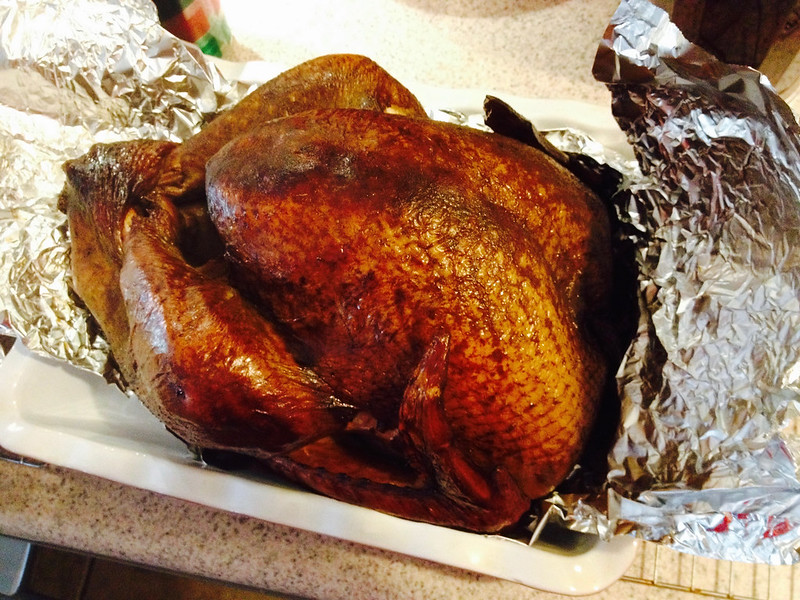HOLIDAYS: How to safely cook the Thanksgiving turkey
Nov. 18, 2022
By Jessica Wesson
Center of Excellence for Poultry Science
U of A System Division of Agriculture
Fast facts:
- Avoid washing the turkey in the sink
- Wash hands before and after handling raw turkey meat
- Temp check, temp check, temp check
(394 words)
FAYETTEVILLE, Ark. — The traditional Thanksgiving meal revolves around the turkey, and food safety is a must to make sure holiday celebrations go off without a hitch.
Kristen Gibson, director of the Center for Food Safety, part of the Arkansas Agricultural Experiment Station, weighed in with some basic tips to keep the Thanksgiving feast safe. Her first piece of advice was to avoid washing the turkey.
“Once your turkey is thawed, most people want to get rid of the slimy feeling on the turkey by rinsing it in the sink,” Gibson said. “By doing that, you’re creating a really great situation for potential cross-contamination. Not only are you potentially spreading pathogens in your sink, but a lot of water can splash out that you don’t see.”
Gloving up
She recommends dabbing the turkey with paper towels to dry the skin and properly disposing of the paper towels in the trash can. Gibson also warned about the dangers of handling the turkey while preparing other foods for the holiday meal.
“You want to be sure your hands are properly cleaned before and after you touch the raw turkey,” Gibson said. “Wearing gloves may help further protect against potential cross-contamination, but you still need to wash your hands before putting gloves on.”
Be sure to change gloves and dispose of dirty pairs in between contact with the raw turkey.
Cooking by the numbers
Once the turkey is cooking, the most important thing to remember is temperature, Gibson said.
“The breast should reach 165 degrees Fahrenheit, and dark meat should reach 170 degrees Fahrenheit,” Gibson said. “You want to make sure you temp it in several spots and do it correctly. Most experts recommend going in at an angle rather than straight down to get into the meat instead of the cavity.”
She said simply cutting the turkey open and eyeballing the meat to determine whether it is fully cooked isn’t a reliable method because looks can be deceiving.
Storing leftovers
After the meal has been eaten and cleanup commences, do not forget about the turkey.
“Don’t leave the turkey on the counter for several hours so people can pick on it throughout the day,” Gibson said. “Put it in the fridge so that it’s stored at the correct temperature.”
For more tips on Thanksgiving food safety, check out this blog post from White County Family Consumer Science agent Katie Cullum.
The Arkansas Agricultural Experiment Station is the research arm of the University of Arkansas System Division of Agriculture.
To learn about extension programs in Arkansas, contact your local Cooperative Extension Service agent or visit www.uaex.uada.edu. Follow us on Twitter and Instagram at @AR_Extension. To learn more about Division of Agriculture research, visit the Arkansas Agricultural Experiment Station website: https://aaes.uada.edu. Follow on Twitter at @ArkAgResearch. To learn more about the Division of Agriculture, visit https://uada.edu/. Follow us on Twitter at @AgInArk.
About the Division of Agriculture
The University of Arkansas System Division of Agriculture’s mission is to strengthen agriculture, communities, and families by connecting trusted research to the adoption of best practices. Through the Agricultural Experiment Station and the Cooperative Extension Service, the Division of Agriculture conducts research and extension work within the nation’s historic land grant education system.
The Division of Agriculture is one of 20 entities within the University of Arkansas System. It has offices in all 75 counties in Arkansas and faculty on five system campuses.
Pursuant to 7 CFR § 15.3, the University of Arkansas System Division of Agriculture offers all its Extension and Research programs and services (including employment) without regard to race, color, sex, national origin, religion, age, disability, marital or veteran status, genetic information, sexual preference, pregnancy or any other legally protected status, and is an equal opportunity institution.
# # #
Media Contact:
Jessica Wesson
jlwesson@uark.edu
479-575-3327
